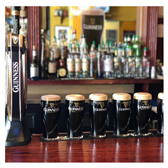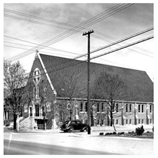I remember seeing a poster with the same curious arithmetic many years earlier when I was celebrating St. Patrick’s Day with some friends at the old Harp and Shamrock pub, located on Lakeshore Road where Door FiftyFive is now. (Anyone else remember “The Harp”?)
A look at Ireland’s flag will help explain the numbers on The Brogue’s licence plate. There are three vertical stripes on the flag. There’s a white stripe in the middle, with green to the left and orange to the right. The green stripe represents the Catholic people of Ireland and the orange represents Irish Protestants. Most Protestant Irish live in the six historic counties located at the north end of the island and they remained united with England, Wales and Scotland when the southern 26 counties became the independent Republic of Ireland. Ever since then, supporters of reunification have chanted “26+6” in support of their vision for One Ireland.
stripes on the flag. There’s a white stripe in the middle, with green to the left and orange to the right. The green stripe represents the Catholic people of Ireland and the orange represents Irish Protestants. Most Protestant Irish live in the six historic counties located at the north end of the island and they remained united with England, Wales and Scotland when the southern 26 counties became the independent Republic of Ireland. Ever since then, supporters of reunification have chanted “26+6” in support of their vision for One Ireland.
The record of early settler families to Port Credit shows that our village has always had a 26+6=1 attitude. Census records for the Blackalls, Carrolls, Donnellys, Madigans, McConnells, McCulleys, Murphys, O’Connors, and O’Neills (who all emigrated to Canada from the 1850s to 1870s, settling in Port Credit) were a more-or-less even mix of Orange and Green when they left Ireland. The Carrolls and Donnellys were Protestants who attended Trinity Anglican Church, but the Blackall and Murphy families, who were also orange in Ireland, became members of St. Mary’s Star of the Sea when they came to Port Credit. They attended the Catholic church just to be among their cultural kin. Isolated from their native land by an ocean, the Irish of Port Credit sought unity with their new neighbours, rather than division, to reinforce their heritage.
 Many of those who attended mass each Sunday were ship’s hands who had committed their lives the other six days of the week to the lake. St. Mary is a patron saint of sailors, and since Port Credit was a community of stonehookers and fishermen when the local Catholic church was founded, all sailors could look to Mary for protection.
Many of those who attended mass each Sunday were ship’s hands who had committed their lives the other six days of the week to the lake. St. Mary is a patron saint of sailors, and since Port Credit was a community of stonehookers and fishermen when the local Catholic church was founded, all sailors could look to Mary for protection.
In her history of Port Credit, titled Credit Valley Gateway, author Betty Clarkson tells of a part of the village that locals called “Corktown” because it was mostly Irish Catholic. (It’s mostly tall apartment buildings today, overlooking the Go station.) Yet in the middle of this Green valley, long ago, was the Orange Lodge (located where Edenshaw’s Westport Condos are now going up, on Ann Street). This was a place for Protestants to meet.
Back in Ireland, the Orange Order might have moved into a Green neighbourhood to antagonize Catholics, but in Port Credit, the “Lodge” was just an all-purpose community hall with affordable rent that happened to be in Corktown.
Charlie Hare, who grew up in this neighbourhood notes, “I’ve never heard this area being referred to as Corktown, but I’m not THAT old. I do recall that every year the Orange Lodge on Ann Street would hold their annual parade. Uniforms, flags, bands . . . it was quite exciting for us kids.”
When St. Mary’s first church was completed in the village in 1880, fewer than 30 families attended the church.
When the current church was built in 1953, St. Mary’s had to hold five masses each Sunday to keep up with the influx of new residents to the town. The Irish who had settled in Port Credit before the first St. Mary’s church was built gathered at homes, with each family of the “church” expected to do its share of the hosting duties. Occasionally the minister of St. Joseph’s Parish in Streetsville could be enticed to make the three-hour horseback journey to Port Credit, and every now and then money was raised by the local parishioners to have one of the many travelling preachers from Toronto swing by, but usually each week’s host doubled as the lay minister. Perhaps that’s were the sense of Irish community in our village started.
This St. Patrick’s Day drink a toast to the early Irish settlers of Port Credit; the green and the orange.
Written by: Richard Collins, Historian
Photos courtesy of the Archives of the Roman Catholic Archdiocese of Toronto, Heritage Mississauga, and The Brogue Irish Pub



 stripes on the flag. There’s a white stripe in the middle, with green to the left and orange to the right. The green stripe represents the Catholic people of Ireland and the orange represents Irish Protestants. Most Protestant Irish live in the six historic counties located at the north end of the island and they remained united with England, Wales and Scotland when the southern 26 counties became the independent Republic of Ireland. Ever since then, supporters of reunification have chanted “26+6” in support of their vision for One Ireland.
stripes on the flag. There’s a white stripe in the middle, with green to the left and orange to the right. The green stripe represents the Catholic people of Ireland and the orange represents Irish Protestants. Most Protestant Irish live in the six historic counties located at the north end of the island and they remained united with England, Wales and Scotland when the southern 26 counties became the independent Republic of Ireland. Ever since then, supporters of reunification have chanted “26+6” in support of their vision for One Ireland. Many of those who attended mass each Sunday were ship’s hands who had committed their lives the other six days of the week to the lake. St. Mary is a patron saint of sailors, and since Port Credit was a community of stonehookers and fishermen when the local Catholic church was founded, all sailors could look to Mary for protection.
Many of those who attended mass each Sunday were ship’s hands who had committed their lives the other six days of the week to the lake. St. Mary is a patron saint of sailors, and since Port Credit was a community of stonehookers and fishermen when the local Catholic church was founded, all sailors could look to Mary for protection.

